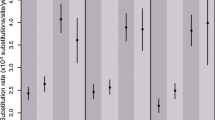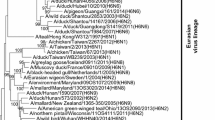Abstract
The primary hosts for influenza A viruses are waterfowl, although gulls and shorebirds are also important in global avian influenza dynamics. Avian influenza virus genes are separated phylogenetically into two geographic clades, American and Eurasian, which is caused by the geographic separation of the host species between these two regions. We surveyed a gregarious and cosmopolitan species, the Great Black-backed Gull (Larus marinus), in Newfoundland, Canada, for the presence of avian influenza viruses. We have isolated and determined the complete genome sequence of an H13N2 virus, A/Great Black-backed Gull/Newfoundland/296/2008(H13N2), from one of these birds. Phylogenetic analysis revealed that this virus contained two genes in the American gull clade (PB1, HA), two genes in the American avian clade (PA, NA), and four genes in the Eurasian gull clade (PB2, NP, M, NS). We analyzed bird band recovery information and found the first evidence of trans-Atlantic migration from Newfoundland to Europe (UK, Spain and Portugal) for this species. Thus, great black-backed gulls could be important for movement of avian influenza viruses across the Atlantic Ocean and within North America.




Similar content being viewed by others
References
Webster RG, Bean WJ, Gorman OT, Chambers TM, Kawaoka Y (1992) Evolution and ecology of influenza A viruses. Microbiol Rev 56:152–179
Olsen B, Munster VJ, Wallensten A, Waldenström J, Osterhaus ADME, Fouchier RAM (2006) Global patterns of influenza A virus in wild birds. Science 312:384–388
Crawford PC, Dubovi EJ, Castleman WL, Stephenson I, Gibbs EPJ, Chen L, Smith C, Hill RC, Ferro P, Pompey J, Bright RA, Medina M-J, Group IG, Johnson CM, Olsen CW, Cox NJ, Klimov AI, Katz JM, Donis RO (2005) Transmission of equine influenza virus to dogs. Science 310:485
Kuiken T, Rimmelzwaan D, van Riel G, van Amerongen M, Baars M, Fouchier RAM, Osterhaus A (2004) Avian H5N1 influenza in cats. Science 306:241
Rambaut A, Pybus OG, Nelson MI, Viboud C, Taubenberger JK, Holmes EC (2008) The genomic and epidemiological dynamics of human influenza A virus. Nature 453:615–619
Salomon R, Webster RG (2009) The influenza virus enigma. Cell 136:402–410
Ip HS, Flint PL, Franson JC, Dusek RJ, Derkson DV, Gill RE Jr, Ely CE, Pearce JM, Lanctot RB, Matsuoka SM, Irons DB, Fischer JB, Oates RM, Petersen MR, Fondell TF, Rocque DA, Pedersen JC, Rothe TC (2008) Prevelence of influenza A viruses in wild migratory birds in Alaska: patterns of variation in detection at a crossroads of intercontinental flyways. Virol J 5:71–81
Koehler AV, Pearce JM, Flint PL, Franson JC, Ip HS (2008) Genetic evidence of interncontinental movement of avian influenza in a migratory bird: the Northern Pintail (Anas acuta). Mol Ecol 17:4754–4762
Wahlgren J, Waldenström J, Sahlin S, Haemig PD, Fouchier RAM, Osterhaus ADME, Pinhassi J, Bonnedahl J, Pisareva M, Grudinin M, Kiselev O, Hernandez J, Falk KI, Lundkvist Å, Olsen B (2008) Gene segment reassortment between American and Asian lineages of the avian influenza virus from waterfowl in the Beringia area. Vector-Borne Zoonotic Dis 8:783–789
Winker K, McCracken KG, Gibson DD, Pruett CL, Meier R, Huettmann F, Wege M, Kulikova IV, Zhuravlev YN, Perdue ML, Spackman E, Suarez DL, Swayne DE (2007) Movements of birds and avian influenza into Alaska. Emerg Infect Dis 13:547–552
Ito T, Okazaki K, Kawaoka Y, Takada A, Webster RG, Kida H (1995) Perpetuation of influenza A viruses in Alaskan waterfowl reservoirs. Arch Virol 140:1163–1172
Krauss S, Obert CA, Franks J, Walker D, Jones K, Seiler P, Niles L, Pryor SP, Obenauer JC, Naeve CW, Widjaja L, Webby RJ, Webster RG (2007) Influenza in migratory birds and evidence of limited intercontinental virus exchange. PLoS Pathog 3:e167. doi:10.1371/journal/ppat/0030167
Munster VJ, Baas C, Lexmond P, Waldenström J, Wallensten A, Fransson T, Rimmelzwaan GF, Beyer WEP, Schutten M, Olsen B, Osterhaus ADME, Fouchier RAM (2007) Spatial, temporal, and species variation in prevalence of influenza A viruses in wild migratory birds. PLoS Pathog 3:e61. doi:10.1371/journal.ppat.0030061
Velarde R, Calvin SE, Ojkic D, Barker IK, Nagy É (2010) Avian influenza virus H13 circulating in Ring-billed Gulls (Larus delawarensis) in Southern Ontario, Canada. Avian Dis 54:411–419
Granter A, Wille M, Whitney H, Robertson GJ, Ojkic D, Lang AS (2010) The genome sequence of an H11N2 avian influenza virus from a Thick-billed Murre (Uria lomvia) shows marine-specific and regional patterns of relationships to other viruses. Virus Genes 41:224–230
Dugan VG, Chen R, Spiro DJ, Sengamalay N, Zaborsky J, Ghedin E, Nolting J, Swayne DE, Runstadler JA, Happ GM, Senne DA, Wang R, Slemons RD, Holmes EC, Taubenberger JK (2008) The evolutionary genetics and emergence of avian influenz A viruses in wild birds. PLoS Pathog 4:e1000076. doi:10.1371/journal/ppat/1000076
Makarova NV, Kaverin NV, Krauss S, Senne D, Webster RG (1999) Transmission of Eurasian avian H2 influenza virus to shorebirds in North America. J Gen Virol 80:3167–3171
Kishida N, Sakoda Y, Shiromoto M, Bai G-R, Norikazu I, Takada A, Laver G, Kida H (2008) H2N5 influenza virus isolates from terns in Australia: genetic reassortments between those of the Eurasian and American lineages. Virus Genes 37:16–21
Widjaja L, Krauss SL, Webby RJ, Xie T, Webster RG (2004) Matrix gene of influenza A viruses isolated from wild aquatic birds: ecology and emergence of influenza A viruses. J Virol 78:8771–8779
Gaston AJ, Jones IL (1998) The Auks: Alcidae. Oxford University Press, New York
Drury WH (1973) Population changes in New England seabirds. Bird-banding 44:267–313
Drury WH (1974) Population changes in New England seabirds. Bird-banding 45:1–15
Robertson GJ, Fifield D, Massaro M, Chardine JW (2001) Changes in nesting-habitat use of large gulls breeding in Witless Bay, Newfoundland. Can J Zool 79:2159–2167
Good TP (1998) Great Black-backed Gull (Larus marinus). The Birds of North American Online. http://bna.birds.cornell.edu/bna/species/330. doi:10.2173/bna.330. Accessed 26 January 2010
Spackman E, Senne DA, Myers TJ, Bulaga LL, Garber LP, Perdue ML, Lohman K, Daum LT, Suarez DL (2002) Development of a Real-Time Reverse Transcriptase PCR Assay for type A influenza virus and the avian H5 and H7 hemagglutinin subtypes. J Clin Microbiol 40:3256–3260
Chan CH, Lin KL, Chan Y (2006) Amplification of the entire genome of influenza A virus H1N1 and H3N2 subtypes by reverse-transcriptase polymerase chain reaction. J Virol Methods 136:38–43
Hoffmann E, Stech J, Y G, Webster RG, Perez DR (2001) Universal primer set for the full-length amplification of all influenza A viruses. Arch Virol 146:2275–2289
Li OTW, Barr I, Leung CYH, Chen H, Guan Y, Peiris JSM, Poon LLM (2007) Reliable universal RT-PCR assays for studying influenza polymerase subunit gene sequences from all 16 haemagluttinin subtypes. J Virol Method 142:218–222
Obenauer JC, Denson J, Mehta PK, Su X, Mukatira S, Finkelstein DB, Xu X, Wang J, Ma J, Fan Y, Rakestraw KM, Webster RG, Hoffmann E, Krauss S, Zheng J, Zhang Z, Naeve CW (2006) Large-scale sequence analysis of avian influenza isolates. Science 311:1576–1580
Zou S (1999) A practical approach to genetic screening for influenza virus variants. J Clin Microbiol 35:2623–2627
Bragstad K, Jorgensen PH, Handberg KJ, Mellergaard S, Corbet S, Fomsgaard A (2005) New avian influenza A subtype combination H7N5 identified in Danish Mallard ducks. Virus Res 109:181–190
Phipps LP, Essen SC, Brown IH (2004) Genetic subtyping of influenza A viruses using RT-PCR with a single set of primers based on conserved sequences within the HA2 coding region. J Virol Methods 122:119–122
Qiu B-F, Liu W-J, Peng D-X, Hu S-L, Tang Y-H, Liu X-F (2009) A reverse-transcription-PCR for subtyping of the neuraminidase of avian influenza viruses. J Virol Methods 155:193–198
Bao Y, Bolotov P, Kiryutin B, Zaslavasky L, Tatusova T, Ostell J, Lipman D (2008) The Influenza virus resource at the National Centre for Biotechnology Institute for Biotechnology Information. Arch Virol 82:596–601
Saitou N, Nei M (1987) The neighbour-joining method: a new method for reconstructing phylogenetic trees. Mol Biol Evol 4:406–425
Felsenstein J (1985) Confidence limits on phylogenies: an approach using the bootstrap. Evolution 39:783–791
Tamura K, Dudley J, Nei M, Kumar S (2007) MEGA4: molecular evolutionary genetics analysis (MEGA) software version 4.0. Mol Biol Evol 24:1596–1599
Huelsenbeck JP, Ronquist F (2001) MRBAYES: Bayesian inference of phylogeny. Bioinformatics 17:754–755
Ronquist F, Huelsenbeck JP (2003) MRBAYES 3: Bayesian phylogenetic inference under mixed models. Bioinformatics 19:1572–1574
Larkin MA, Blackshields G, Brown NP, Chenna R, McGettigan PA, McWilliam H, Valentin F, Wallace IM, Lopez R, Thompson JD, Gibson TJ, Higgins DG (2007) Clustal W and Clustal X version 2.0. Bioinformatics 23:2947–2948
ESRI (2008) ArcGIS 9.3. Environmental Systems Research Institute. Redlands, California. http://www.esri.com/software/arcgis/index.html
du Feu CR, Joys AC, Clark JA, Fiedler W, Downie IS, van Noordwijk AJ, Spina F, Wassenaar R, Baillie SR (2009) EURING Databank geographical index 2009. http://www.euring.org/edb. Accessed 20 August 2009
Lyngs P (2003) Migration and winter ranges of birds in Greenland. Medd Grønl Biosci 38:1–67
Olsen KM, Larsson H (2004) Gulls of Europe, Asia and North America. Christopher Helm Publishing Ltd, London
Gaston AJ, Brewer D, Diamond AW, Woodsworth EJ, Collins BT (2008) Canadian atlas of bird banding. Volume 2: seabirds, 1921–1995, 2nd edn. Canadian Wildlife Service Special Publication, Ottawa
Gustafson MW, Hildenbrand J (1999) Bird Banding Laboratory online. http://www.pwrc.usgs.giv/bbl. Accessed 15 August 2009
Acknowledgments
We thank P. Ryan, A. Granter, C. Keane and A. Blundon for assistance with sample collection and processing, the Environment Canada Banding Office and C. du Feu from EURING for assistance with bird banding and band recovery data, and G. Humphries for assistance with GIS-based data visualization. Support for this work was received from the Newfoundland and Labrador Department of Natural Resources and the Strategic Applications of Genomics in the Environment (STAGE) program at Environment Canada. MW was supported by a CGS-M fellowship from the Natural Sciences and Engineering Research Council (NSERC) and a merit fellowship from Memorial University. Research in ASL’s lab is supported by grants from NSERC, the Canada Foundation for Innovation, and the Industrial Research and Innovation Fund from the Government of Newfoundland and Labrador.
Author information
Authors and Affiliations
Corresponding author
Additional information
Nucleotide sequence data reported are available in the GenBank database under the accession numbers: GU724150–GU724157.
Electronic supplementary material
Below is the link to the electronic supplementary material.
Rights and permissions
About this article
Cite this article
Wille, M., Robertson, G.J., Whitney, H. et al. Reassortment of American and Eurasian genes in an influenza A virus isolated from a great black-backed gull (Larus marinus), a species demonstrated to move between these regions. Arch Virol 156, 107–115 (2011). https://doi.org/10.1007/s00705-010-0839-1
Received:
Accepted:
Published:
Issue Date:
DOI: https://doi.org/10.1007/s00705-010-0839-1




